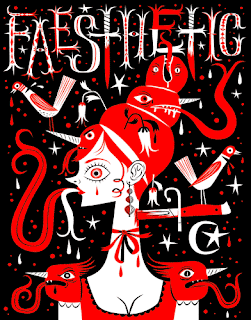






Victor Moscoso (born 1936) is an American illustrator and comic book artist, especially noted for his work in the late 1960s as a designer of psychedelic art and concert posters (many for The Fillmore) and as a contributor to underground comix (he is among the artists who regularly appear in Zap Comix).
Psychedelic art is art inspired by the psychedelic experience induced by drugs such as LSD, mescaline, and psilocybin. The word "psychedelic" (coined by British psychologist Humphrey Osmond) means "mind manifesting". By that definition all artistic efforts to depict the inner world of the psyche may be considered "psychedelic". However, in common parlance "Psychedelic Art" refers above all to the art movement of the 1960s counterculture. Psychedelic visual arts were a counterpart to psychedelic rock music. Concert posters, album covers, lightshows, murals, comic books, underground newspapers and more reflected not only the kaleidoscopically swirling patterns of LSD hallucinations, but also revolutionary political, social and spiritual sentiments inspired by insights derived from these psychedelic states of consciousness.
My favorite poster that he did was the one of the peacock in purple, turquoise blue and lime green. I like this due to the colour and the peacock design as well. Below are my five images I like the best of his and I find he colours appealing to me.
http://www.google.com.au/search?hl=en&q=Victor+Moscoso&btnG=Google+Search&meta=
http://www.victormoscoso.com/directory.html
http://www.victormoscoso.com/
http://www.victormoscoso.com/directory.html
http://en.wikipedia.org/wiki/Victor_Moscoso
http://en.wikipedia.org/wiki/Zap_Comix
http://www.collectable-records.ru/images/post/moscoso/index.htm

































 His famous psychedelic posters of Bob Dylan, Donovan and others rank as classics of the genre, alongside the work of Rick Griffin, Hapshash and the Coloured Coat and Milton Glaser. His covers, cartoons and illustrations were a central feature of Oz magazine, both in Australia and in London. Sharp was educated at Cranbrook private school, where one of his teachers was the noted artist Justin O'Brien. In 1960 Martin enrolled at the National Art School at East Sydney, where began his artistic career, contributing to the shortlived student magazine The Arty Wild Oat, along with fellow artists Garry Shead and John Firth Smith. He also began submitting cartoons to The Bulletin. In 1961 he enrolled for two terms in Architecture at Sydney University before returning to the NAS.
His famous psychedelic posters of Bob Dylan, Donovan and others rank as classics of the genre, alongside the work of Rick Griffin, Hapshash and the Coloured Coat and Milton Glaser. His covers, cartoons and illustrations were a central feature of Oz magazine, both in Australia and in London. Sharp was educated at Cranbrook private school, where one of his teachers was the noted artist Justin O'Brien. In 1960 Martin enrolled at the National Art School at East Sydney, where began his artistic career, contributing to the shortlived student magazine The Arty Wild Oat, along with fellow artists Garry Shead and John Firth Smith. He also began submitting cartoons to The Bulletin. In 1961 he enrolled for two terms in Architecture at Sydney University before returning to the NAS.



















